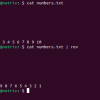Unleash the Power of tac Command in Linux for Viewing Files

Linux commands are essential tools for any user, system administrator, or developer working. Whether you are a beginner or an experienced user, understanding and mastering the power of Linux commands can greatly enhance your productivity and efficiency in managing and troubleshooting Linux systems. Many powerful and obscure commands can make working with the Linux command line a lot easier.
Let’s...
Quickly Reverse File Contents With This Linux Command

Most people who use Linux operate in a graphical user interface (GUI), which provides easy-to-use menus and icons for common tasks. However, many power users prefer to work in the Linux command line, as it provides a more powerful and efficient way to interface with the operating system. Here is a cheat sheet that covers the most commonly used Linux commands.
This article demonstrates the use of...
How To Mount Remote FTP Site As A Local Folder From Terminal In Linux Mint / Ubuntu

Here’s how to mount remote ftp site as a local folder in Linux Mint / Ubuntu:
1. Issue the following command at the terminal to install curlftpfs –
sudo apt-get install curlftpfs
2. After the installation is complete, issue the following command at the terminal to create a directory that will be used a local mountpoint (in our case the directory name is ‘test’) –
mkdir...
How To Configure Your Time Zone From Terminal In Linux Mint / Ubuntu

If you are working on terminal in Linux Mint / Ubuntu and need to configure your time zone without using the GUI, follow the following steps:
1. Issue the following command at the terminal –
sudo dpkg-reconfigure tzdata
2. Now select your geographic area and then select ‘<Ok>’ to proceed.
3. Finally, select the city that corresponds to your time zone and then select ‘<Ok>’...
How To Quickly Generate A Report Of System’s Network Interfaces From Linux Terminal

Here’s how to quickly generate a report of system’s network interfaces from Linux terminal:
1. Issue the following command at the terminal –
sudo ip addr
2. The output of the above command will generate a report of all the network interfaces present in the system along with their properties.
If looking for a Linux shell script that does something similar as above, check out the related...
How To Quickly Find Out The Maximum Amount Of Supported Memory In Linux

Sometimes you me be required to to find out how much memory is supported by you Linux system. Here’s how you can quickly find out the maximum amount of memory supported in Linux from terminal:
1. Issue the following command at the terminal –
sudo dmidecode -t 16
2. The resulting output will show you the maximum memory supported by you Linux system, but of course, the amount of memory that...